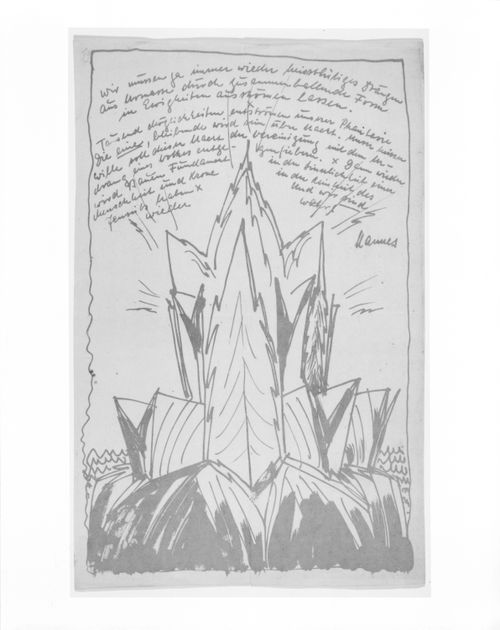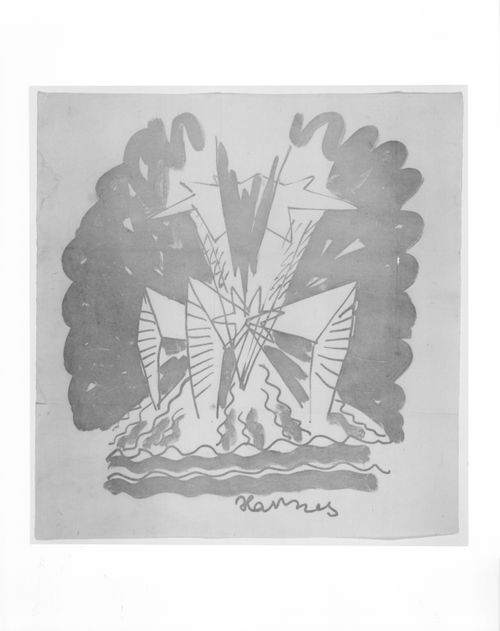dessins
DR1988:0019:003
Description:
Sketches signed "Angkor", pseudonym of Hans Luckhardt for Die gläserne Kette correspondence.
n.d.
Sketches of the Concert Hall project by Hans Luckhardt
Actions:
DR1988:0019:003
Description:
Sketches signed "Angkor", pseudonym of Hans Luckhardt for Die gläserne Kette correspondence.
dessins
n.d.
documents textuels
DR1988:0019:004
Description:
Letter signed "Zachen", pseudonym of Wassili Luckhardt for Die gläserne Kette correspondence.
n.d.
Letter from Wassili Luckhardt to an unidentified correspondent
Actions:
DR1988:0019:004
Description:
Letter signed "Zachen", pseudonym of Wassili Luckhardt for Die gläserne Kette correspondence.
documents textuels
n.d.
documents textuels
DR1988:0019:005
Description:
Letter signed "Zachen", pseudonym of Wassili Luckhardt for Die gläserne Kette correspondence.
n.d.
Letter from Wassili Luckhardt to an unidentified correspondent
Actions:
DR1988:0019:005
Description:
Letter signed "Zachen", pseudonym of Wassili Luckhardt for Die gläserne Kette correspondence.
documents textuels
n.d.
Série(s)
Hermann Finsterlin
AP162.S1
Description:
Series documents the contribution of artist Hermann Finsterlin to the correspondence circle of Die gläserne Kette. Finsterlin wrote under the pseudonym Prometh (sometime appears as "Prometheus"). Born in Munich in 1897, Finsterlin studied at Munich University in chemistry, then in physics and medicine, and later in philosophy. He studied painting at the Kunstakademie in Munich in 1917 and 1918 and exhibited his work at the Ausstlelling für unbekannte Architekten. He published in "Frühlich", a magazine edited by Bruno Taut in which works by some members of Die gläserne Kette were featured. He painted frescoes in Tripoli, Majorca, and Tenerife. During the Nazi period, Finsterlin was commissionned to paint frescoes and portraits for the regime, but most of his work was destroyed during the war. He died in Stuttgart, Germany, in 1973. (Source: Ian Boyd Whyte, Bruno Taut and the Architecture of Activism. Cambridge: Cambridge University Press, 1982) The series comprises part of the correspondence of Hermann Finsterlin to the Die gläserne Kette circle, including a postcard. The series also includes some drawings by Finsterlin.
1919-1923
Hermann Finsterlin
Actions:
AP162.S1
Description:
Series documents the contribution of artist Hermann Finsterlin to the correspondence circle of Die gläserne Kette. Finsterlin wrote under the pseudonym Prometh (sometime appears as "Prometheus"). Born in Munich in 1897, Finsterlin studied at Munich University in chemistry, then in physics and medicine, and later in philosophy. He studied painting at the Kunstakademie in Munich in 1917 and 1918 and exhibited his work at the Ausstlelling für unbekannte Architekten. He published in "Frühlich", a magazine edited by Bruno Taut in which works by some members of Die gläserne Kette were featured. He painted frescoes in Tripoli, Majorca, and Tenerife. During the Nazi period, Finsterlin was commissionned to paint frescoes and portraits for the regime, but most of his work was destroyed during the war. He died in Stuttgart, Germany, in 1973. (Source: Ian Boyd Whyte, Bruno Taut and the Architecture of Activism. Cambridge: Cambridge University Press, 1982) The series comprises part of the correspondence of Hermann Finsterlin to the Die gläserne Kette circle, including a postcard. The series also includes some drawings by Finsterlin.
series
1919-1923
documents textuels
DR1988:0023:013
Description:
Letter signed "Glas", pseudonym of Taut for Die gläserne Kette correspondence.
October 20, 1920
Letter from Bruno Taut to Wenzel Hablik
Actions:
DR1988:0023:013
Description:
Letter signed "Glas", pseudonym of Taut for Die gläserne Kette correspondence.
documents textuels
October 20, 1920
Série(s)
Hans Hansen
AP162.S4
Description:
Series documents the contribution of architect Hans Hansen to the correspondence circle of Die gläserne Kette, with Hansen writing under the pseudonym Antischmitz. Born in Roetgen, Germany, in 1886, Hansen studied architecture in Cologne. After the war, Hansen joined the circle Cologne Dadaists, contributed to the magazine "Der Ventilor", and published "Das Erlebnis der Architektur". From 1922, he worked on commissions for the Catholic Church in Germany, including his most known project for the St. Bruno Church in Cologne-Kletteberg (1924-1926). He died in Cologne in 1966. (Source: Ian Boyd Whyte, Bruno Taut and the Architecture of Activism. Cambridge: Cambridge University Press, 1982) The series comprises part of the correspondence of Hans Hansen to the Die gläserne Kette circle.
1920
Hans Hansen
Actions:
AP162.S4
Description:
Series documents the contribution of architect Hans Hansen to the correspondence circle of Die gläserne Kette, with Hansen writing under the pseudonym Antischmitz. Born in Roetgen, Germany, in 1886, Hansen studied architecture in Cologne. After the war, Hansen joined the circle Cologne Dadaists, contributed to the magazine "Der Ventilor", and published "Das Erlebnis der Architektur". From 1922, he worked on commissions for the Catholic Church in Germany, including his most known project for the St. Bruno Church in Cologne-Kletteberg (1924-1926). He died in Cologne in 1966. (Source: Ian Boyd Whyte, Bruno Taut and the Architecture of Activism. Cambridge: Cambridge University Press, 1982) The series comprises part of the correspondence of Hans Hansen to the Die gläserne Kette circle.
series
1920
Série(s)
AP162.S5
Description:
Series documents the contribution of architect Carl Krayl to the correspondence circle of Die gläserne Kette, with Krayl writing under the pseudonym Anfang. Born in 1890 in Weinsberg, Germany, Krayl worked on building sites between 1906 to 1909 in preparation for the architectural studies he would undertake from 1910 to 1912 at the Kunstgewerbeschule and the Polytechnikum at Stuttgart. He was employed as a military architect during the First World War and was stationed at Ingolstatd. After the war, Krayl joinded the Arbeitsrat für Kunst lead by Bruno Taut. Between 1919 to 1921 he contributed to "Frühlich", a magazine published by Taut which featured works by some members of Die Gläserne Kette. Krayl joined Bruno Taut in the city architecture department at Magdeburg. From 1923, he worked independently and executed private and public architectural projects. During the Nazi regime he worked as a draftsman for the German State Railway from 1938 to 1946. He died in 1946 in Werder an der Havel, Germany. (Source: Ian Boyd Whyte, Bruno Taut and the Architecture of Activism. Cambridge: Cambridge University Press, 1982) The series comprises part of Carl Krayl's correspondence to the Die gläserne Kette circle, along with related drawings and photographs.
1918-1945
Carl Krayl
Actions:
AP162.S5
Description:
Series documents the contribution of architect Carl Krayl to the correspondence circle of Die gläserne Kette, with Krayl writing under the pseudonym Anfang. Born in 1890 in Weinsberg, Germany, Krayl worked on building sites between 1906 to 1909 in preparation for the architectural studies he would undertake from 1910 to 1912 at the Kunstgewerbeschule and the Polytechnikum at Stuttgart. He was employed as a military architect during the First World War and was stationed at Ingolstatd. After the war, Krayl joinded the Arbeitsrat für Kunst lead by Bruno Taut. Between 1919 to 1921 he contributed to "Frühlich", a magazine published by Taut which featured works by some members of Die Gläserne Kette. Krayl joined Bruno Taut in the city architecture department at Magdeburg. From 1923, he worked independently and executed private and public architectural projects. During the Nazi regime he worked as a draftsman for the German State Railway from 1938 to 1946. He died in 1946 in Werder an der Havel, Germany. (Source: Ian Boyd Whyte, Bruno Taut and the Architecture of Activism. Cambridge: Cambridge University Press, 1982) The series comprises part of Carl Krayl's correspondence to the Die gläserne Kette circle, along with related drawings and photographs.
series
1918-1945
Série(s)
AP162.S8
Description:
Series documents the contribution of architect Bruno Taut to the correspondence circle of Die gläserne Kette. Bruno Taut participated under the pseudonym Glas. Born in 1880 in Königsberg, Germany, Bruno Taut studied architecture at the Bauwerkschule in Königsberg. After working in architectural firms from 1903 to 1909, he worked in partnership with Franz Hoffman and later with his brother Max Taut. Bruno Taut undertook various architectural projects including housing projects, public commissions, and later projects for universities and schools. In 1918, he founded the Arbeisrat für Kunst, a union of architects, painters, writers and other artists based in Berlin and dedicated to bring architectural and artisit tendencies of the time to a broader public. This union also involved some members of the Die gläserne Kette circle. Between 1920 and 1921, Bruno Taut was editor to the magazine "Frühlich". He taught architecture at the Technische Hochschule at Berlin-Charlottenburg from 1930 to 1932, and undertook a working visit in Russia in 1932 to 1933. After spending time in Japan between 1933 and 1936 due to enforced emigration, he taught at the Academy of Arts in Istanbul. He died in Istanbul in 1938. (Source: Ian Boyd Whyte, Bruno Taut and the Architecture of Activism. Cambridge: Cambridge University Press, 1982) This series comprises part of Bruno Taut's correspondence to the Die gläserne Kette circle, along with related drawings and documents. The series also includes photographic materials of some of his architectural projects.
between 1919 and 1920
Bruno Taut
Actions:
AP162.S8
Description:
Series documents the contribution of architect Bruno Taut to the correspondence circle of Die gläserne Kette. Bruno Taut participated under the pseudonym Glas. Born in 1880 in Königsberg, Germany, Bruno Taut studied architecture at the Bauwerkschule in Königsberg. After working in architectural firms from 1903 to 1909, he worked in partnership with Franz Hoffman and later with his brother Max Taut. Bruno Taut undertook various architectural projects including housing projects, public commissions, and later projects for universities and schools. In 1918, he founded the Arbeisrat für Kunst, a union of architects, painters, writers and other artists based in Berlin and dedicated to bring architectural and artisit tendencies of the time to a broader public. This union also involved some members of the Die gläserne Kette circle. Between 1920 and 1921, Bruno Taut was editor to the magazine "Frühlich". He taught architecture at the Technische Hochschule at Berlin-Charlottenburg from 1930 to 1932, and undertook a working visit in Russia in 1932 to 1933. After spending time in Japan between 1933 and 1936 due to enforced emigration, he taught at the Academy of Arts in Istanbul. He died in Istanbul in 1938. (Source: Ian Boyd Whyte, Bruno Taut and the Architecture of Activism. Cambridge: Cambridge University Press, 1982) This series comprises part of Bruno Taut's correspondence to the Die gläserne Kette circle, along with related drawings and documents. The series also includes photographic materials of some of his architectural projects.
series
between 1919 and 1920
DR1988:0020:004
Description:
Reproduction of a drawing of Scharoun published in "Ruf zum Bauen", a publication by the Arbeiterrats für Kunst, in 1920. Drawing signed "Hannes", pseudonym of Scharoun for Die gläserne Kette correspondence.
1919 or 1920
Untitled drawings by Hans Scharoun
Actions:
DR1988:0020:004
Description:
Reproduction of a drawing of Scharoun published in "Ruf zum Bauen", a publication by the Arbeiterrats für Kunst, in 1920. Drawing signed "Hannes", pseudonym of Scharoun for Die gläserne Kette correspondence.
DR1988:0020:005
Description:
Reproduction of a drawing of Scharoun published in "Ruf zum Bauen", a publication by the Arbeiterrats für Kunst, in 1920. Drawing signed "Hannes", pseudonym of Scharoun for Die gläserne Kette correspondence.
1919 or 1920
Untitled drawings by Hans Scharoun
Actions:
DR1988:0020:005
Description:
Reproduction of a drawing of Scharoun published in "Ruf zum Bauen", a publication by the Arbeiterrats für Kunst, in 1920. Drawing signed "Hannes", pseudonym of Scharoun for Die gläserne Kette correspondence.

